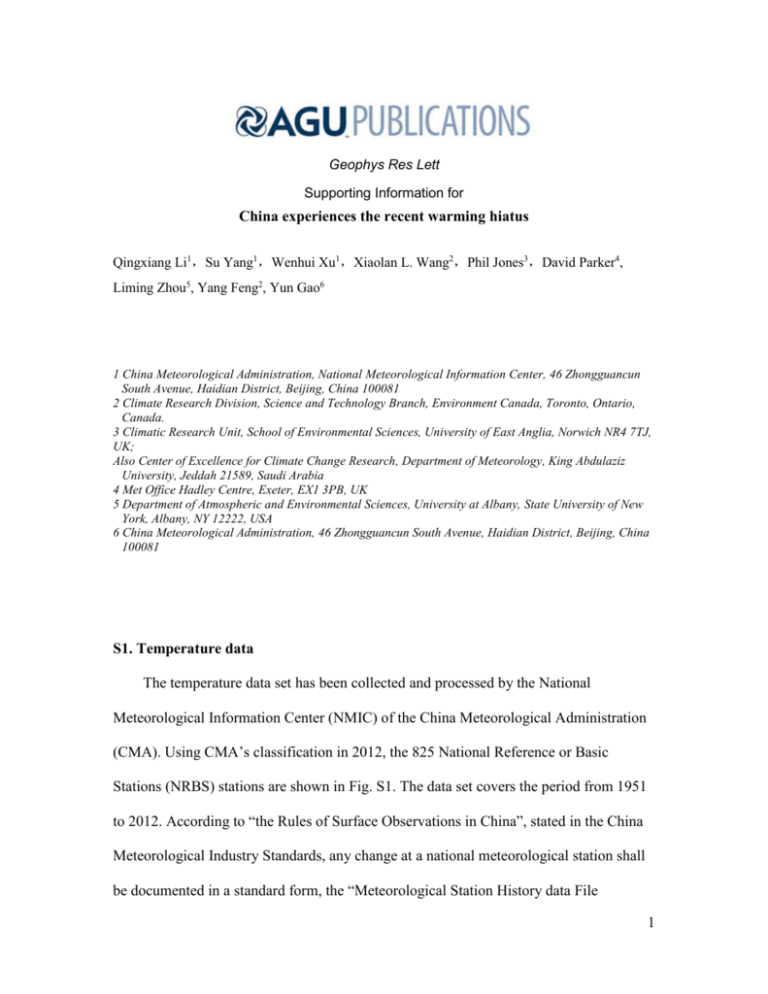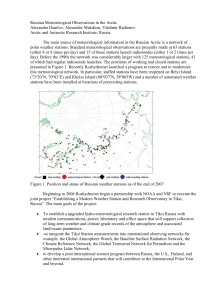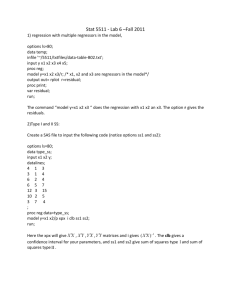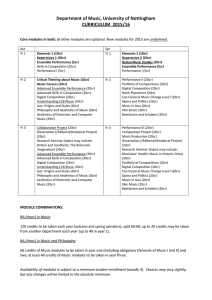grl52555-sup-0001-supplementary
advertisement

Geophys Res Lett Supporting Information for China experiences the recent warming hiatus Qingxiang Li1,Su Yang1,Wenhui Xu1,Xiaolan L. Wang2,Phil Jones3,David Parker4, Liming Zhou5, Yang Feng2, Yun Gao6 1 China Meteorological Administration, National Meteorological Information Center, 46 Zhongguancun South Avenue, Haidian District, Beijing, China 100081 2 Climate Research Division, Science and Technology Branch, Environment Canada, Toronto, Ontario, Canada. 3 Climatic Research Unit, School of Environmental Sciences, University of East Anglia, Norwich NR4 7TJ, UK; Also Center of Excellence for Climate Change Research, Department of Meteorology, King Abdulaziz University, Jeddah 21589, Saudi Arabia 4 Met Office Hadley Centre, Exeter, EX1 3PB, UK 5 Department of Atmospheric and Environmental Sciences, University at Albany, State University of New York, Albany, NY 12222, USA 6 China Meteorological Administration, 46 Zhongguancun South Avenue, Haidian District, Beijing, China 100081 S1. Temperature data The temperature data set has been collected and processed by the National Meteorological Information Center (NMIC) of the China Meteorological Administration (CMA). Using CMA’s classification in 2012, the 825 National Reference or Basic Stations (NRBS) stations are shown in Fig. S1. The data set covers the period from 1951 to 2012. According to “the Rules of Surface Observations in China”, stated in the China Meteorological Industry Standards, any change at a national meteorological station shall be documented in a standard form, the “Meteorological Station History data File 1 Format”. These station history data files (i.e., metadata) are checked and stored by the provisional meteorological information centers (PMICs) and also by NMIC. Table 1 reports the statistics of station relocations. Among the 825 stations analyzed in this study, a total of 669 stations have been moved at least once. Previous research showed that a number of station temperature series are inhomogeneous1-3, and some homogenized temperature datasets have been developed to correct the bias in climate trends detection over China1-5 The observed values were quality controlled using the NMIC conventional procedures, including the climatological limit check, the station or regional extremes check, the internal consistency check, and the temporal and spatial consistency checks. We then homogenized time series of daily maximum and minimum temperatures recorded at 825 stations in China, separately, over the period from 1951 to 2010, using both metadata and the penalized maximum t test with the first order autocorrelation being accounted for to detect changepoints, and using the quantile-matching algorithm to adjust data time series to diminish discontinuities (Wang and Feng, 2010)6. Station relocation was found to be the main cause for discontinuities, followed by station automation. The effects of discontinuities on estimation of long-term trends in the annual mean and extreme indices of temperature are illustrated. The data homogenization is shown to have improved the spatial consistency of estimated trends 5. 2 S2. Surface Solar Radiation (SSR) data The SSR data is also quality controlled and processed by NMIC. There are about 130 sites over mainland China where SSR has been monitored and we used 93 stations with high SSR data completeness7. (Fig S2). Similar to temperature, the station relocations and instrumentations change cause inhomogeneity in SSR series, but it is more difficult to detect their discontinuities and adjust them, because the sparse station distribution makes it difficult to construct reference series of SSR data from nearby stations when homogenizing the temporal series. However, Ju et al.(2006)employed sunshine duration (SSD) totals as reference series to identify the change points of SSR data. Sunshine duration series have a much higher density of observational sites than SSR and are generally highly correlated with SSR. The results showed that most of the SSR potential change points were in the 1970s and 1990s8. In addition, we check the metadata for SSR stations (NMIC, 2013), and find that the instrumentation and observational rules have remained the same since the last change of instruments in the 1990s9. So we believe that the data in 1998-2012 are more stable and fit for analyzing in this paper. S3. Trend analysis for 1998-2012 Since we are analyzing extreme temperatures (which are not normally distributed), we used the Kendall method developed by Wang and Swail (2001)10-12 to estimate linear trends and test for their statistical significance at the 5% level: the procedures and steps are given in APPENDIX A of Wang and Swail (2001) . Table 1 shows trends in seasonal 3 and annual mean maximum (Tx) and minimum temperatures (Tn) and DTR, and Fig S3 shows comparisons of the trends for different periods. S4. Surface air temperature (SAT) trends from 20CR We plotted surface air temperature trends from the 20th Century Reanalysis (20CR)13, which is driven by atmospheric pressure data, and for 1998-2012 it reproduced cooling over China in winter, in agreement with observations, with little change in summer. As 20CR does not use air temperature data or aerosol forcings, the winter cooling must have come from the atmospheric circulation, i.e. an increase in winds from the north responding to the assimilated atmospheric pressure data. But 20CR provides output only on a 6-hourly basis, not true maximum and minimum temperatures, so we only looked at mean temperatures. It is noteworthy that the SAT change trends derived from 20CR are similar to those from observational SAT data. This means the SAT change in JJA and DJF are related to regional atmospheric circulations. (Fig S4) Acknowledgement 20th Century Reanalysis V2 data were provided by the NOAA/OAR/ESRL PSD, Boulder, Colorado, USA, from their Web site at http://www.esrl.noaa.gov/psd/. Support for the 20th Century Reanalysis Project dataset is provided by the U.S. Department of Energy, Office of Science Innovative and Novel Computational Impact on Theory and Experiment (DOE INCITE) program, and Office of Biological and Environmental 4 Research (BER), and by the National Oceanic and Atmospheric Administration Climate Program Office. 5 50 40 30 20 80 90 100 110 120 130 140 Fig.S1. The 825 stations analyzed in this study, including 682 National Basic Stations (NBS) (red circle) and 143 National Reference Stations (NRS) (blue star) stations. 6 Fig.S2. The 130 SSR stations over China, and 93 of them (the length of SSR time series is longer than 10 years) analyzed in this study. 7 (a) 8 (b) 9 (c) 10 (d) 11 (e) Fig.S3. The annual (a), Spring (b), Summer (c), Fall (d) and winter (e) trends calculated by Kendall’s slope estimator developed by Wang and Swail (2001)10-12. 12 13 14 15 Fig.S4. The Summer (JJA) and Winter (DJF) surface air temperature trends during 1961-2012 and 1998-2012 from the 20th Century Reanalysis (20CR)13 and homogenized data (below panel for each 20 CR plots) 16 Table.S1. The statistics of station relocations (up to 31 December 2009). Frequency Never Once Twice >= 3 times Total Number of 156 231 203 235 825 stations (18.9%) (28.0%) (24.6%) (28.5%) relocated 17 References 1. Li, Q. , X. Liu, H. Zhang, T. C. Peterson and D. R. Easterling (2004) , Detecting and adjusting temporal inhomogeneity in Chinese mean surface air temperature data, Adv., Atmos., Sci., 21(2), 260-268. 2. Song F , Qi H , Qian W. Quality control of daily metorological data in China , 195122000 : A new dataset . Int J Climat ,2004 , 24 : 8532870 3. Li Z, Yan Z (2009) Homogenized daily mean/maximum/minimum temperature series for China from 1960-2008. Atmos Ocean Sci Lett 2(4):237–243. 4. Li, Q., H. Zhang, J. Chen, W. Li, X. Liu and P. Jones (2009), A mainland China homogenized historical temperature dataset of 1951-2004, Bull. Amer. Meteor. Soc.,, 90, 1062-1065, doi: 10.1175/2009BAMS2736.1 5. Xu, W., Q. Li, X. L. Wang, S. Yang, L. Cao, and Y. Feng (2013) , Homogenization of Chinese daily surface air temperatures and analysis of trends in the extreme temperature indices, J. Geophys. Res. Atmos., 118, doi:10.1002/jgrd.50791. 6. Wang, X. L., and Y. Feng, published online 2010: RHtestsV3 User Manual. Available online at http://cccma.seos.uvic.ca/ETCCDMI/RHtest/RHtestsV3 UserManual.doc. Climate Research Division, Science and Technology Branch, Environment Canada, Toronto, Ontario, Canada. 26 pp. 7. Yang, S., G. Y. Shi, B. Wang D. Li(2013), Characteristics of surface temperature in China during global ‘dimming’ and ‘brightening’ periods.Plateau Meteor., 32(4), 993-999, doi:10.7522/j.issn.1000-0534.2012.00095. In Chinese. 18 8. Ju X., Q. Tu and Q. Li (2006) Homogeneity test and reduction of monthly total solar radiation over China, J. Nanjing Inst. Meteor., 29(3), 336-341. 9. Metadata for Solar Rediation, collected and Qced by National Meteorological Information Center, 2013 10. Wang, Xiaolan L., Val R. Swail. Changes of Extreme Wave Heights in Northern Hemisphere Oceans and Related Atmospheric Circulation Regimes. J. Climate, 14, 2204–2221. doi:http://dx.doi.org/10.1175/1520- 0442(2001)014<2204:COEWHI>2.0.CO;2 (2001) 11. Zhang, X., and F. Zwiers. Comment on “Applicability of prewhitening to eliminate the influence of serial correlation on the Mann-Kendall test” by Sheng Yue and Chun Yuan Wang. Water Resourc. Res., 40, W03805 (2004). 12. Kendall, M. G., and J. D. Gibbons, Rank Correlation Methods, 5th Ed., edited by E. Arnold, London, U. K., 320 pp., (1981). 13. Compo GP, Whitaker JS, Sardeshmukh PD, Matsui N, Allan RJ, Yin X, Gleason BE, Vose RS, Rutledge G, Bessemoulin P, Brönnimann S, Brunet M, Crouthamel RI, Grant AN, Groisman PY, Jones PD, Kruk M, Kruger AC, Marshall GJ, Maugeri M, Mok HY, Nordli Ø, Ross TF, Trigo RM, Wang XL, Woodruff SD and Worley SJ (2011) The Twentieth Century Reanalysis Project. Quarterly J Roy Meteorol Soc, 137, 1-28 DOI: 101002/qj776 19








